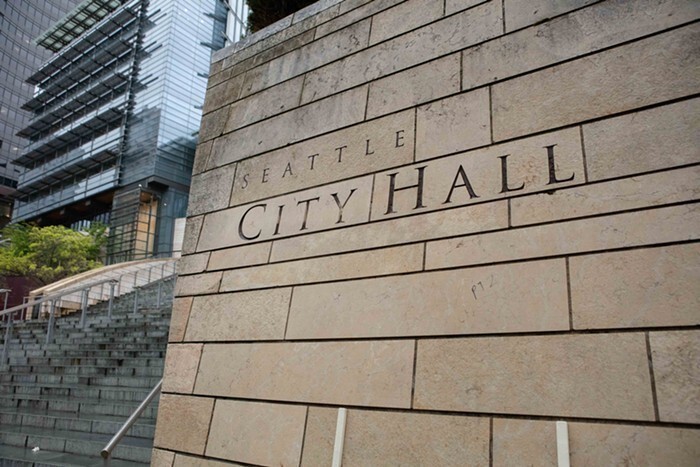This afternoon, King County Elections (KCE) added 7,000 of 10,000 remaining ballots in the 2023 general election. With the dust mostly settled, KCE reports a turnout of 46% in Seattle, which exceeded expectations this year and outpaced the County’s turnout of 37%. Still, the city’s turnout fell short compared to 2019, when 49% of registered voters cast a ballot and picked the “progressive” candidate in almost every race. Left-leaning candidates in 2023 likely suffered as a result of the lower turnout, losing in every race, mostly by tight margins where 3% higher turnout could have made all the difference.
A few candidates pulled off decisive victories: Tech lawyer Rob Saka won with 54% in District 1, cannabis business owner Joy Hollingsworth won with 53% in District 3, and former judge Cathy Moore won with 64% in District 5.
Incumbents Tammy Morales in District 2 and Dan Strauss in District 6 inched ahead of their opponents last week, as KCE counted more last-minute progressive ballots.
As of Friday, things seemed close in District 4, where urbanist father Ron Davis trailed just 400 votes behind his more conservative opponent, Maritza Rivera. The race also looked close in District 7, where incumbent Andrew Lewis sat 500 votes behind Bob Kettle.
As of the Monday drop, neither of those two made up the difference. Lewis, who already conceded, made up some ground. He now trails Kettle by 465 votes, 49% to 51%. Davis closed the gap a little and now trails Rivera by 303 votes, 49% to 50%.
It looks like it's over for Lewis and Davis. A spokesperson for KCE said only 1,278 ballots remain in Seattle, and there does not appear to be enough contested ballots in either race for Lewis or Davis to pull off a comeback. According to the ballot return dashboard, KCE flagged signature issues with 222 ballots in D4 and 229 in D7. Though these so-called “challenged” ballots typically lean progressive, there doesn’t appear to be enough in either race to overcome the difference, though we don't really know how many unchallenged votes are left to count in each district.
But “curing” those “challenged” ballots could bring those races within the 0.5% margin necessary to trigger an automatic recount, and there are so more ballots out there. Here’s how to make sure your ballot got counted:
If KCE finds an issue with your signature, they will contact you via the email or phone number you put on your ballot. (You can also check to see if KCE counted your ballot by logging into the King County voter information portal, but hopefully KCE will notify you first.)
If you did not put an email or phone number on your ballot, then please do that next time, and also check your mail. KCE will send you a letter informing you of the issue along with a signature resolution form that will allow you to fix it. If that letter slips through the cracks somehow, then you can print out a signature resolution form here. And, if you don’t have a printer, remember that you can print 10 black-and-white pages at Seattle Public Libraries for free each week.
You can return the form in three ways: take a clear photo or a scan of the entire form and send it to voter.services@kingcounty.gov, mail it (no stamp required), or drop it off in person at KCE’s headquarters in Renton.
You can also use this online tool to resolve the issue and “cure” your ballot. Heads up—the website I just linked did not work on my computer, but it did work on my phone, so if it gives you trouble, then try a different device. Keep in mind that updating your signature with the online portal means signing with a digital signature. If your digital signature strays too far from the look of your handwritten signature, then KCE may challenge your signature again in future elections.
While KCE cures ballots for the love of democracy, campaigns will try to resolve signature issues to swing close elections in their favor. Campaigns in District 2 for incumbent Tammy Morales and shelter-hater Tanya Woo already started hunting for contested ballots among their supporters.
Campaigns can get a list of contested ballots from KCE, which includes voters’ addresses. Morales’s campaign prioritized people on the list who donated or gave Democracy Vouchers to their candidate or who live in her strongest precincts. They do their best not to knock on doors that will likely vote for Woo since they want to win. Duh.
According to new research from the Evans School of Public Policy, young people, those aged 18 to 25, represented 5% of all uncounted ballots in Washington’s 2022 election. For comparison, elections agencies in Washington did not count 0.8% of ballots submitted from voters aged 46 to 65 and 0.3% of those submitted from voters older than 65. This makes younger voters the most likely of any demographic to see their ballot contested and uncounted.
Typically, those younger voters tend to vote for the more progressive candidate in the race. So, many of the contested ballots in this election likely belong to Davis and Lewis, as they represent the more progressive candidate in their respective races.
So, please, to all the hot, very busy young people out there: You already put in the work of walking to the drop box, make sure you check to see that your ballot got counted.
















